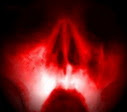
Country: Japan
Genre: Action / Musical / Cyberpunk
Running Time: 116 min
Director: Sogo Ishii
Cast: Takanori Jinnai, Michirou Endo, Machizo Machida, Shigeru Izumiya…
GHOUL RATING:
***(*)
4-
Story: Set in a barren, futuristic Tokyo of highways and wastelands, a rowdy group of punk bands and their fans gather to protest the construction of a nuclear power plant. Riot police and the factory owner's yakuza friends soon move in to break it up. However, the arrival of mysterious, metal-clad bikers and a revolt among the disgruntled construction crew makes for a situation that spirals dangerously out of control… This description, taken from the DVD sleeve provides far more linearity, logic and plot than can be found in the actual film. BURST CITY is preoccupied more with conveying the energy than with telling a story, so… be warned: this city is bursting with power, but is certainly not plot-driven!
Review: Sogo Ishii is not a film director: he never went the beaten path in Japanese film industry (which is, usually, to start as an assistant and rise from there). Too passionate about his vocation, he was also too impatient to wait, and while still a student he grabbed a camera and went out there to shoot life as he saw it. He found himself in the middle of Japanese punk revolution in which he participated both as a musician (he was a singer and a guitarist) and director of promo and concert videos. His motto was: ''To experience the video not with just the eye and the ear, but to feel it through the whole body.''
Because of that, BURST CITY is not a film: it is a raw, vivid, breathing and bleeding document of an era. At the same time, it is a root of new Japanese cinema. It spearheaded the career of a major director, a pioneer of the 'new wave' of Japanese film, the man who brought the youthful punk attitude and fresh sensibility to the way movies were made. Before Tsukamoto and Miike, there was Ishii. Before TETSUO there was BURST CITY.
BURST CITY is the world's first cyberpunk movie, made in the same year as VIDEODROME and BLADE RUNNER, and predating William Gibson's 1984 novel 'Neuromancer'). Set in an indefinite near future, it presents a world of speed and noise, a world of asphalt and metal, of engines roaring along cold grey highways, of colorful gangs clad in leather and rags MAD MAX-style. It created a typically Japanese brand of cyberpunk in which alienation, discontent and anger are painted against the background of a desert slightly different than that in MAD MAX: it is 'the desert of the real', the spiritual void of contemporary affluent Japanese society. There are no literal, visible ruins: quite the contrary, the apocalypse of the soul has left the industry, office buildings and high-rises untouched. They still domineer the grey landscape, summoning their destruction, inviting dreams of a real apocalypse which pervade so much of Japanese cyberpunk, and genre film in general, from BURST CITY through AKIRA and TETSUO all the way to DEAD OR ALIVE, PULSE and beyond.
Ishii's own two previous films, PANIC HIGH SCHOOL and CRAZY THUNDER ROAD, are the only precedents to BURST CITY: brimming with youthful angst, they are the visual equivalent of punk music. Perhaps too raw for their own good, they are superseded by BURST CITY, because that was his first film with some real budget which provided a room for serious stylization and directorial flair. Ishii's themes, style and direction are showcased at their peak in BURST CITY, and his ideal of ''feeling the movie through the whole body'' is achieved 110%. This is obvious from the stunning opening minutes in which his camera takes a furious joyride down the (mostly deserted) highways, bridges and streets, with their lights turned into beautiful abstract paintings, a SF ambience which needs no robots, space ships or even huge fancy buildings like those in BLADE RUNNER. Rapid-fire editing, non-linear structure and disregard for plot are just some elements of Ishii's style.
Characters are reduced to their colorful image, sketched but never explored: after all, most of them are not even actors but members of the leading punk bands of the time. Instead of any specific person, in BURST CITY Ishii's camera becomes a real protagonist and runs, shakes, drives, and cuts insanely among the people, gangs, cars, motorbikes and cityscapes thus presenting one of the most fascinating examples of the doctrine 'show, don't tell!' His characters communicate their feelings and visions through numerous songs, through action, movement, fight, and Ishii masterfully penetrates their lifestyle and worldview completely abandoning words (dialogue, narration, etc.).
DVD [ NTSC, Region 1 ] : Luckily, Discotek's special edition does full justice to the importance of BURST CITY, and presents it in a manner that could hardly be surpassed. Occasional grain and murkiness come from the film's 16mm origins and are part of its appeal: or perhaps you would like your punk movie to be a slick, over-produced big-budget extravaganza? It is presented in anamorphic 1.85:1 ratio. Pity that the sound, so important for a film like this, is only in Dolby Digital 2.0, and that some songs cannot be heard loudly and fully. Again, this has to do with the original source material, and it is what it is. This edition really shines when it comes to extras: Tom Mes provides three pages of excellent liner notes, while the disc itself showcases textual background of the film, its protagonists and the whole punk scene. There is also a theatrical trailer, rare b/w stills gallery and soundtrack lyrics (unfortunately, copyright issues prevented the option of having a bonus CD with the soundtrack the way it was done recently with Ishii's ELECTRIC DRAGON: 80,000 VOLTS). Excellent carton case envelops a regular, plastic one (with a different cover) and rounds up this wonderful edition.








Нема коментара:
Постави коментар